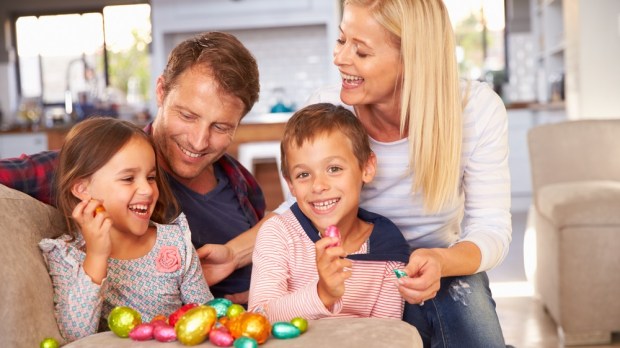Lenten Campaign 2025
This content is free of charge, as are all our articles.
Support us with a donation that is tax-deductible and enable us to continue to reach millions of readers.
Our spiritual life is tangible. It’s not praying on one side and leading our everyday life on the other. It’s our whole being that becomes one in God, because He loves us in every instant, in all the little things that comprise our existence. So, celebrating Easter must not be limited to our participation in the Mass, but in all that makes us human.
A family celebration
Easter begins on the night of Holy Saturday — the vigil. COVID restrictions or having very young children may not allow you to participate in an Easter Vigil Mass. In this case, you can celebrate “this most holy night when Our Lord Jesus Christ passed over from life to death” (the Easter Liturgy) in a ceremony at home. It can be organized by simply reproducing some elements of the Easter ritual: a big Paschal candle from which each lights their taper; a bowl with holy water to dip one’s hand before making the sign of the cross in commemoration of baptism; the reading from the Gospel; a few joyful chants, naturally including “alleluia.” As in church, we can start in a totally dark room, which can then be lit.
We must not hesitate to let our older kids participate. To help children stay attentive during readings that they oftentimes find confusing, we may bring a prayer book so they can follow the text. For those who still don’t know how to read, we may bring an illustrated Bible to point out the episodes evoked in the reading: Creation, the binding of Isaac, etc. Even if it’s hard for kids to pay attention and stay focused during the Vigil, we may be assured that they will be particularly sensitive to the special atmosphere of Easter night.
Inaugurating family traditions surrounding Easter
After the vigil, why not share some Easter bread or another Easter treat? Food matters to most kids … and not just to kids! Of course, this is trivial, but it’s not without its importance. A sumptuous meal, beautiful clothing, a house filled with flowers and lights, surprises (baskets full of sweets and egg hunts) — all this matters and impresses kids, who will keep a found memory of Easter as a big and beautiful feast.
As with Christmas, we can inaugurate our own family traditions surrounding Easter: it can be exchanging candles decorated with ribbons on Easter night or coloring eggs that can be later given to neighbors; it can be an “Easter cake” (inspired by the East European kulich) baked only in this occasion; or small Easter breads in the shape of a fish, recalling the ichthus of the early Christians.
A menorah, representing the seven weeks of Easter
Home embellishment, improving a prayer corner, chants and music, Easter breakfast, greeting cards sent to friends and relatives: so many important details that make Easter feast special. Easter is prolonged by Eastertide, as is attested by the candles illuminating the our churches until the night of Pentecost. It’s a good idea to highlight this at home, especially by the decoration in the prayer corner.
A menorah, representing the seven weeks of Easter, can be lit every night: but contrary to the Advent wreath, where candles are lighted one by one, the seven candles of menorah are lit at the same time. To be sure, as of Easter night we are all invited to share in the Resurrection wholeheartedly and with immense joy!
Christine Ponsard

Read more:
The Easter 2021 Gift Guide for Catholic Kids

